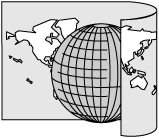cylindrical projections/cylindrical equal-area map projection
- cylindrical projections/cylindrical equal-area map projection
A cylindrical map projection onto a cylinder tangent to a sphere, showing the geographic meridians as a family of equal-spaced parallel straight lines perpendicular to a second family of parallel straight lines. They represent the geographic parallels and are so spaced as to produce an equal-area map projection. The equal-area condition preserves a constant ratio between corresponding ground and map areas. This projection must not be confused with the Mercator projection, to which it bears some general resemblance. True or correct scale will obtain along the great circle of tangency or the two homothetic small circles of intersection. If the axis of the cylinder is parallel to the axis of the earth, the parallels and meridians will appear as right, perpendicular lines. Points on the earth equally distant from the tangent great circle (equator) or small circles of intersection (parallels equally spaced on either side of the equator) will have equal scale departure. The pattern of deformation will therefore be parallel to the parallels, as a change in scale occurs in a direction perpendicular to the parallels. If the cylinder is turned 90° with respect to the earth’s axis, the projection is said to be transverse, and the pattern of deformation will be symmetric with respect to a great circle through the poles. If the turn of the cylinder is less than 90°, an oblique projection results.

Aviation dictionary.
2014.
Look at other dictionaries:
Cylindrical equal-area projection — of the world; standard parallel at 40°N … Wikipedia
Lambert cylindrical equal-area projection — In cartography, the Lambert cylindrical equal area projection, Lambert cylindrical projection, or cylindrical equal area projection is a cylindrical, equal area map projection. The invention of this projection is attributed to the Alsatian… … Wikipedia
Map projection — A medieval depiction of the Ecumene (1482, Johannes Schnitzer, engraver), constructed after the coordinates in Ptolemy s Geography and using his second map projection A map projection is any method of representing the surface of a sphere or other … Wikipedia
Map — /map/, n. Walter, c1140 1209?, Welsh ecclesiastic, poet, and satirist. Also, Mapes /mayps, may peez/. * * * I Graphic representation, drawn to scale and usually on a flat surface, of features usually geographic, geologic, or geopolitical of an… … Universalium
map — mappable, adj. mapper, n. /map/, n., v., mapped, mapping. n. 1. a representation, usually on a flat surface, as of the features of an area of the earth or a portion of the heavens, showing them in their respective forms, sizes, and relationships… … Universalium
MAP — See modified American plan. * * * I Graphic representation, drawn to scale and usually on a flat surface, of features usually geographic, geologic, or geopolitical of an area of the Earth or of any celestial body. Globes are maps represented on… … Universalium
Gall-Peters projection — The Gall Peters projection is one specialization of a configurable equal area map projection known as the equal area cylindric or cylindric equal area projection. The Gall Peters achieved considerable notoriety in the late 20th century as the… … Wikipedia
Scale (map) — The scale of a map is defined as the ratio of a distance on the map to the corresponding distance on the ground. If the region of the map is small enough for the curvature of the Earth to be neglected, then the scale may be taken as a constant… … Wikipedia
Mercator projection — of the world between 82°S and 82°N. Mercator world … Wikipedia
World map — This article is about maps of the Earth. For other uses, see World map (disambiguation). Historical map of the world by Ortelius, 1570 CE A world map is a map of the surface of the Earth, which may be made using any of a number of different map… … Wikipedia

